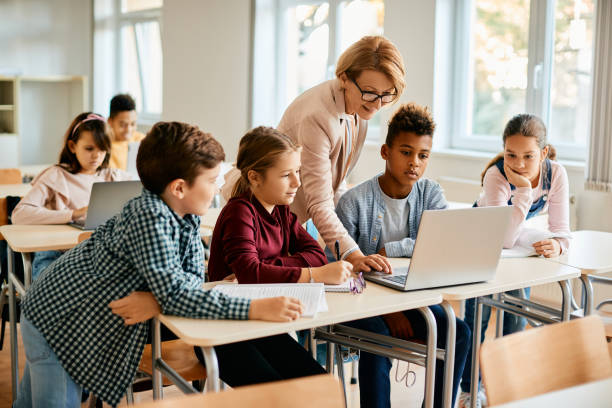The Best Primary Science Tuition Singapore for Effective Learning Methods
The Best Primary Science Tuition Singapore for Effective Learning Methods
Blog Article
Checking Out the Different Training Methods in Primary Scientific Research Education Today
The landscape of primary science education and learning is evolving, with numerous mentor methods obtaining importance in contemporary class. Inquiry-based discovering, hands-on experiments, and the combination of technology are redefining exactly how teachers involve young minds. Furthermore, collaborative techniques and differentiated direction are being utilized to cater to the varied requirements of students, improving both interaction and understanding. As we analyze these techniques, inquiries arise regarding their effectiveness and the ramifications for future instructional practices. What might these changes in method mean for the following generation of learners?
Inquiry-Based Knowing
Inquiry-Based Discovering (IBL) is a pedagogical technique that urges trainees to check out scientific ideas through wondering about, investigation, and hands-on trial and error. This technique highlights the duty of trainees as active individuals in their learning, promoting crucial reasoning and analytical abilities. By engaging with real-world concerns, pupils end up being motivated and curious, which enhances their understanding of scientific principles.
In IBL, teachers serve as facilitators, guiding students as they navigate their inquiries as opposed to delivering info directly. This student-centered method permits differentiation, suiting numerous learning styles and speeds. Trainees establish abilities in formulating theories, creating experiments, and evaluating data, which are crucial for scientific literacy.
Furthermore, IBL fosters partnership amongst pupils, encouraging them to share searchings for and concepts. This collective inquiry advertises social abilities and a sense of neighborhood within the class. Furthermore, the procedure of questions urges resilience, as trainees learn to accept failing as a stepping stone toward understanding.
Hands-On Experiments
Hands-on experiments are a vital component of reliable scientific research education, enhancing the concepts of inquiry-based understanding. These experiments permit students to engage directly with scientific ideas, cultivating a much deeper understanding via experiential knowing. By adjusting products and observing end results, young students can understand abstract theories in tangible methods.
Such tasks advertise essential reasoning and problem-solving abilities, as trainees hypothesize outcomes, conduct experiments, and evaluate outcomes. This process encourages them to ask questions, fine-tune their understanding, and create a scientific mindset. In addition, hands-on experiments can be tailored to varied discovering styles, ensuring that all pupils have the opportunity to involve meaningfully with the material.
Moreover, hands-on experiments frequently urge cooperation amongst peers, advertising teamwork and interaction abilities. Functioning in groups enables trainees to share ideas, go over searchings for, and pick up from each other, which enhances their total instructional experience.
Integrating hands-on experiments into the main science curriculum not just enriches the learning setting however likewise cultivates a lifelong interest in scientific research. By proactively taking part in their education, students are more probable to establish a passion for scientific query that expands beyond the class.

Technology Combination
Integrating technology into key science education and learning has ended up being increasingly vital in fostering trainee engagement and enhancing finding out outcomes. Using digital devices, such as interactive simulations, virtual laboratories, and academic software, offers trainees with chances to discover clinical concepts in cutting-edge means. These sources help with a deeper understanding of complicated subjects by allowing learners to visualize and manipulate variables that would be not practical in a standard class setup.
In addition, technology integration motivates personalized finding out experiences. Students can advance at their very own speed, taking another look at tough concepts with multimedia click this site sources, which accommodate different discovering styles. This adaptability not only sustains specific growth yet also grows a sense of autonomy in learners.
Additionally, modern technology acts as a bridge additional hints to real-world scientific research, attaching students with existing research and expert contributions. Accessibility to clinical journals and on the internet databases widens trainees' perspectives on clinical questions and cultivates essential assuming skills.
Collaborative Learning
Joint understanding plays an essential role in main scientific research education and learning by promoting synergy and communication skills amongst trainees. This technique motivates learners to collaborate, share knowledge, and participate in problem-solving, which improves their understanding of scientific principles. By joining team tasks, pupils learn to express their ideas, pay attention to diverse viewpoints, and work out remedies, all of which are vital abilities in both real-world and scholastic contexts.

Research suggests that collaborative understanding can cause raised motivation and involvement in science subjects, as trainees locate satisfaction in common experiences (primary science tuition Singapore). Additionally, this approach prepares trainees for future collaborative undertakings, outfitting them with the skills necessary for efficient synergy in college and expert atmospheres. Eventually, welcoming joint knowing in key scientific research education and learning can substantially improve the learning experience and promote a deeper understanding of scientific query
Set Apart Guideline

Set apart instruction can materialize in various means, such as varying the web content, processes, or items of knowing. As an example, educators may make use of tiered tasks that give varying levels of intricacy, allowing pupils to function at their respective readiness degrees. In addition, flexible organizing methods can assist in collaboration amongst students with different abilities, fostering peer knowing.
Analysis plays an important role in this technique, as it informs instruction and helps instructors recognize each pupil's unique demands. Developmental analyses, such as observations and tests, can guide teachers in readjusting their techniques to boost discovering outcomes. primary science tuition Singapore. Ultimately, by implementing separated direction in primary scientific research education, educators can grow a much more effective and fair understanding setting, empowering all pupils to reach their full possibility in comprehending scientific phenomena
Final Thought
In summary, the diverse mentor techniques in key scientific research education, consisting of inquiry-based understanding, hands-on experiments, modern technology assimilation, collective learning, and separated direction, collectively add to an extra efficient learning environment. These approaches promote crucial thinking, analytic abilities, and a much deeper comprehension of scientific ideas. By implementing these approaches, instructors can produce engaging and encouraging classrooms that address the diverse demands of students, eventually fostering a lifelong rate of interest in scientific research and boosting academic achievement.
Inquiry-Based Discovering (IBL) is an instructional strategy that urges trainees to explore clinical concepts with doubting, examination, and hands-on trial and error.Collective knowing plays a crucial role in key scientific research education and learning by promoting teamwork and interaction abilities among pupils.Research study shows that collective knowing can lead to boosted motivation and interaction in science subjects, as trainees discover satisfaction in shared experiences.In cultivating a comprehensive discovering setting, differentiated guideline arises as a key method to suit the varied requirements and capabilities of trainees in main scientific research education and learning. Inevitably, by applying set apart guideline in primary science education, teachers can grow a more fair and efficient understanding atmosphere, equipping all pupils to reach their full possibility in understanding scientific sensations.
Report this page